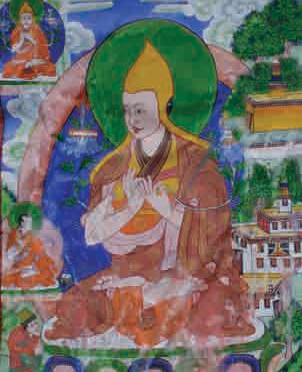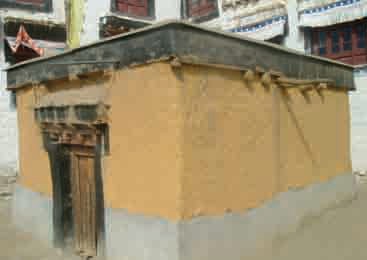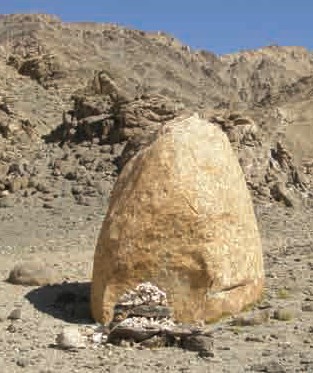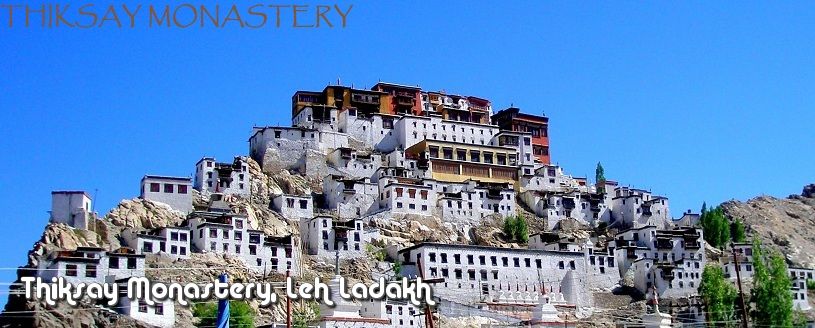 The first Thiksay Rinpoche, Doe Chamsem Sherab Sangpo, was born in Sharmo Village,
near Leh, and as a young boy travelled
to Tibet with traders from Ladakh. When he arrived
in Lhasa, he asked an old woman in the
Barkhor the name of the best
scholar or teacher inside Tibet.
Without a word, she pointed
to Ganden Monastery. He began his
studies at Ganden,
receiving teachings and initiations and becoming a disciple
of the founder of the Gelugpa
school of Tibetan
Buddhism, Jhe Tsong
Khapa.
The first Thiksay Rinpoche, Doe Chamsem Sherab Sangpo, was born in Sharmo Village,
near Leh, and as a young boy travelled
to Tibet with traders from Ladakh. When he arrived
in Lhasa, he asked an old woman in the
Barkhor the name of the best
scholar or teacher inside Tibet.
Without a word, she pointed
to Ganden Monastery. He began his
studies at Ganden,
receiving teachings and initiations and becoming a disciple
of the founder of the Gelugpa
school of Tibetan
Buddhism, Jhe Tsong
Khapa.
Having completed his studies, Jhe Tsong Khapa instructed Doe Chamsem Sherab Zangpo to return
to Ladakh, asking
him to spread the ‘yellow hat tradition’, prophesying that, “On the right bank of the river Sita (Indus) my
teachings will flourish”. Jhe Tsong
Khapa gave him a statue
made from dried
blood from his nose, saying
that when he arrived in Ladakh, he should give it to a famous
person whom he would
meet. On his arrival in Ladakh, Changsem
Sherab Sangpo was told
of a famous King in Nubra, King Nyima Namgyal,
and made a request to meet him. The king was told that a poor monk was requesting an audience, but refused to see him, whereupon
Chamsem Sherab Zangpo
returned with the statue to Leh.
That night,
the King in Leh, King Takpa Bumde, dreamt
that a special person was coming to see him. The next morning he told the
gatekeeper to admit
anyone who came requesting an audience
that day. When Chamsem
Sherab Zangpo came,
he met the King and presented
the statue, and the King began to take teachings from him.
 After several
years, Chamsem Sherab Zangpo explained
to the King that his teacher
had told him to spread
the teachings of Buddhism in Ladakh, and requested land to build a temple. The
King offered land in
a village
called Stakmo,
where Changsem Sherab Sangpo built the Lhakang Serpo (Yellow
Temple).
After several
years, Chamsem Sherab Zangpo explained
to the King that his teacher
had told him to spread
the teachings of Buddhism in Ladakh, and requested land to build a temple. The
King offered land in
a village
called Stakmo,
where Changsem Sherab Sangpo built the Lhakang Serpo (Yellow
Temple).
Chamsem Sherab Zangpo continued to teach throughout Ladakh, but it became clear that the Lhakang Serpo was not attracting the requisite number of monks, and with
his disciple
Poen Palden Sherab,
they decided to find an alternative place. Walking through
the neighbouring valley
of Arzoo, they came
across a unique yellow stone in the parched desert.
Feeling that this was an important
and holy site, they performed
a special ritual, making offering cakes or torma. As they completed the ritual, a crow swooped down and snatched
the torma from the
rock, disappearing with it in
its beak.
 Upon searching
for the torma, the monks found it placed still in one piece
in the doorway of the King Palde Rigpa Gon’s palace on a hill in a nearby village
near to the Indus River. The palace became the site of Thiksay Monastery, ‘thik’ meaning ‘exactly right’, while the stone itself was known as
‘Thik-do’. Poen Palden Sherab was the son of one of the King’s Ministers
and with this strong connection, the monastery flourished, with monks joining from all over Ladakh,
Spiti, Nubra and Zangskar.
Upon searching
for the torma, the monks found it placed still in one piece
in the doorway of the King Palde Rigpa Gon’s palace on a hill in a nearby village
near to the Indus River. The palace became the site of Thiksay Monastery, ‘thik’ meaning ‘exactly right’, while the stone itself was known as
‘Thik-do’. Poen Palden Sherab was the son of one of the King’s Ministers
and with this strong connection, the monastery flourished, with monks joining from all over Ladakh,
Spiti, Nubra and Zangskar.
Meanwhile Chamsem Sherab Zangpo continued to travel throughout Ladakh giving teachings and instituting the Gelugpa school’s
practices. He taught at many monasteries including Spituk, Deskit
Monastery in Nubra, Likir Monastery
and Karsha Monastery in Zangskar.
He passed away in Phugtal Monastery, south of Padum in Zangskar. It is said that a juniper
tree grew from hairs from his head, and this can still be
found in Phugtal.
Chamsem Sherab Zangpo had given authority
to Poen Palden Sherab to develop
Thiksay Monastery, and because
of his connection with the King,
he was able to make much progress. Part of the original
royal palace still remains to this day. The connection with the King’s family
is maintained through
the original Palden Lhamo temple on the highest level of the monastery. The only
female allowed to enter the temple is the Queen
of Stok, showing the original link between the monastery and the family.
Over the next six hundred years, the monastery
grew in size and influence and increased its agricultural holdings
enabling it to support itself.
When the
present 9th Thiksay
Rinpoche returned from
Tibet in 1959 however, he found the monastery
in disrepair, and few resources
available to him. He began to build up the income of the monastery and embraced new technology in order to help. The first
tractor in Ladakh belonged
to Thiksay Monastery, and Rinpoche also introduced the first thresher
for harvesting grain, mills for grinding corn and many other innovations, all with the purpose of supporting the monastery. Finding the original Dukhang
in a very poor state
of repair, he first
renovated it, and then began
work on the Zimchung, Notsar Phuntsog
(lamas’ accommodation).
Later, Rinpoche extended
the area of the Choera
(debate courtyard) over the old grain store, replacing
the beams which had
collapsed. He built a new Dhuchok Khang, (main temple), with a school building below. He also built the new common kitchen and
dining hall and opened the museum.


















